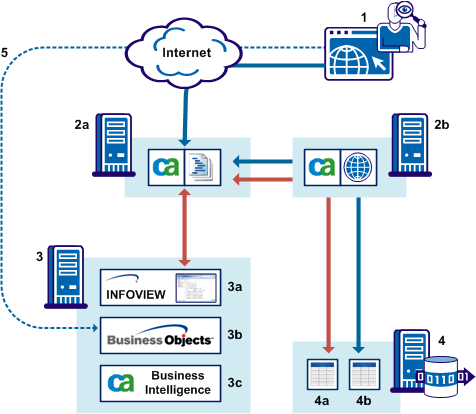

CA Data Protection can integrate with BusinessObjects Enterprise. When integration is enabled, iConsole users can run BusinessObjects reports to view and understand activity detected by CA Data Protection.
Integration is provided through BusinessObjects Enterprise components on the iConsole front end web server and through CA components and BusinessObjects components on the reports server.
The diagram below shows an example integration.

A user logs on to the CA Data Protection iConsole (1). The iConsole URL points to the front-end Web server (2a).
The iConsole front-end web server (2a) generates the HTML for the iConsole's Review tab. This tab lists all the CA Data Protection reports and BusinessObjects Enterprise reports available to the user. It also displays a link to the BusinessObjects Enterprise portal, InfoView (3a). In order to display the BusinessObjects Enterprise reports and a link to InfoView, the front-end web server connects to BusinessObjects Enterprise (3b).
The front end server also connects to an iConsole application server (2b). The application server submits CA Data Protection standard reports to the CMS (4) and returns the results to the front-end web server.
For BusinessObjects reports, the application server submits report requests to BusinessObjects Enterprise (3b). BusinessObjects Enterprise directly queries the CA Data Protection CMS database (4) and renders the results. The results are displayed directly in the iConsole.
The reports server (3) hosts BusinessObjects Enterprise (3b). Compatibility with CA products is provided through CA Business Intelligence (3c). This is a wrapper that includes a BusinessObjects Enterprise installation. When you install CA Business Intelligence on this server, BusinessObjects Enterprise and its web portal, InfoView (3a), also get installed.
The CMS (4) services all report requests submitted by the iConsole application server. For BusinessObjects reports, BusinessObjects Enterprise queries a set of tables in the data warehouse (4a). For standard CA Data Protection reports, the CMS queries the normal set of user tables and event tables (4b).
Alternatively, a user can browse directly to the BusinessObjects Enterprise portal, InfoView (5). However, this means they must manually log in to BusinessObjects Enterprise. By contrast, if they launch the portal from the iConsole Review tab, single sign-on ensure that they do not need to separately log in to BusinessObjects Enterprise.
|
Copyright © 2015 CA Technologies.
All rights reserved.
|
|